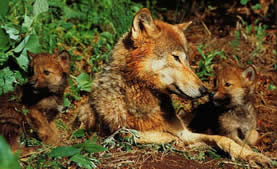 discovered serendipitously through the Fugly Horse of the Day blog.
discovered serendipitously through the Fugly Horse of the Day blog.Much as we've seen in Yellowstone and other prime wolf habitat, it came to the attention of people (as always, a little late) that wolves in the Grand Canyon region of Arizona were a keystone to the health of the natural environment. Wolves were killed both to protect the natural prey animals, thought to be helpless and 'harmless', and to protect the interests of stockmen who later moved through the region. The government actually hired hunters solely to shoot wolves, mountain lions, and other predators. As the GCWRP states on their website "The exterminators did not understand and, therefore, gave no regard to the important role predators play in nature." Now days we have a much better understanding of the role apex predators like wolves and mountain lions play in balancing nature. With the extermination of these key species, the deer numbers skyrocketted. Without predators to keep them in check, the prey animal populations become weakened, animals die of disease and starvation, and often overfeed on their habitat, causing long term habitat destruction.
In 1999 Mexican Wolves were reintroduces into the Blue Range region of eastern Arizona, a critical first step in wolf recovery. However, unnatural territory boundaries continue to keep wolves from prospering as well as they should. Just as in Montana and Wyoming wolves can be shot for leaving designated recovery areas, wolves in Arizona are trapped and taken back to the Blue Range, essentially killing any hope of creating sustainable, genetically diverse wolf populations.
But the GCWRP seeks to tell us all hope is not lost. They cite that "The Grand Canyon Ecoregion has been identified by wildlife ecologists as offering extraordinary habitat for wolf recovery. The region contains vast expanses of undeveloped land in national parks, monuments, and forests, and contains ample food for wolves. Scientific research indicates that this region, extending from the Mogollon Rim all the way up to the high plateaus of southern Utah, can sustain at least 200 wolves."
So why don't we all give our wolves a chance to flourish and live without borders?


No comments:
Post a Comment